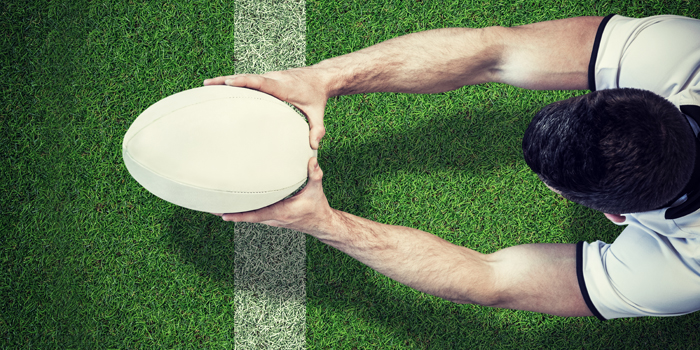
Game Day (Saturday)
Immediately, post-game recovery takes priority over performance to ensure that players are ready to train on the first day of the week. Rehydration is essential for ensuring that you are back close to your pre-game weight. It is important to weigh in and out of a game, especially in warmer and more humid environments. A general rule of thumb is that for every kilogram you are down in your post-game weigh-in, you should consume one liter of fluids. This should be consumed slowly, 250ml every 20 minutes, to allow for absorption to take place. This can be combined with a carbohydrate-rich meal to ensure that glycogen storage is initiated or a combination protein shake is used to cover bother bases.
RECENT: Choosing 1 of 10 Programs to Individualize the Training Process
Following this crucial first phase of the recovery process, it is important to look at physical measures, such as cold water immersion at 12 degrees for 10 minutes, or a contrast bath (hot and cold) utilizing a protocol such as two minutes at 12 degrees followed by one minute at 40 degrees for three to five rotations. Finally, it is recommended that players put on compression tights for a minimum of two hours, then move up to a dinner consisting of high carbohydrates and lean proteins before ideally getting at least eight hours-plus of sleep over the next few days. For those players who did not get onto the field, I will leave it for them to decide if they wish to do top-ups immediately after the game or wait until we potentially have a better number of players to do conditioning games on Game Day +2.
Game Day +1 (Sunday)
A day of psychological as well as physiological recovery is necessary for this day. Time with family and friends away from rugby is an important element of this day. Although there will be an injury clinic, usually in the morning sometime, the rest of the day is free. For an away game, this could be a travel day as well. It is so important that players do something as a means of recovery when they get home or before they board their mode of transport home. My preference is a pool or, even better, an ocean-based recovery session of movement drills, swimming, and stretching. Below is a regular session that I have used when I have access to a pool:
- 100m freestyle kick, flippers okay, hold onto kickboard, do not stop after 50m
- 3 minutes in spa, sauna, or steam
- 100m backstroke kick, flippers okay, hold kickboard on the chest, do not stop after 50m
- 3 minutes in spa, sauna, or steam
- 50m freestyle with a pool buoy between upper thighs, turn into 50m breaststroke
- 3 minutes in spa, sauna, or steam
- 100m aqua jogging with a buoyancy belt
- 3 minutes in spa, sauna, or steam
- 100m aqua jogging with a buoyancy belt.
- Finish!
Other activities, such as walking and bike riding at a low intensity and at a time of about 20–30 minutes, are also excellent means of stimulating recovery. This combined with static stretching and even a yoga class has benefits, but for me, it is important to ensure that the players have options that suit them, not have sessions forced upon them that they may not be as compliant about. After all, this day is a player-driven individual session for the most part.
Game Day +2
Monday
Individualized and graded involvement based on game playing time (acute), cumulative game time (chronic), calculated involvements and contact, age of player, injury history, wellness questionnaire, and monitoring results and medical check.
Level 1: Anaerobic/conditioning games, repeated speed, gym
Level 2: Self-paced games, gym
Level 3: Off-feet cross-training session, upper-body weights
Level 4: Pool session, stretch, massage
Level 5: Self-paced pool session, stretch, massage
All players to attend team walk/jog through tactical session
Game Day +2 (Monday)
I have found that most players achieve peak levels of soreness at 48 hours post game, so this day is, for the most part, still recovery-focused but with the introduction of tactical elements and a top-up day for players who did not have significant game time in the previous game.
Players will complete a wellness questionnaire focusing on elements such as level of soreness/tightness, fatigue levels, sleep quality and quantity, and being mentally ready to train. Following this a monitoring session that usually includes:
- Knee to wall
- Groin squeeze (with blood pressure cuff)
- Vertical jump using OptoJump
- Sit and reach
- Grip squeeze
These are related to ongoing averages and to a discussion between medical and S&C staff before chats with specific players if required based on results.
The level of involvement is calculated based on game stats, collisions, tackles, scrums, lineouts, and cleaning out rucks. These are all equated to numeric values, with game time added and key GPS metrics included as well. High-speed meterage, total distance or meters per minute, how many consecutive games a player has played, the player’s age, and the player’s prior injury history all complete a picture that allows us to channel players into specific groups for this day’s training. There is always a debate and conjecture because every player loves being involved in conditioning games. So, discussion is key to having the player do what is best for him or her and for the team going forward to the next game.
To conclude the day, the team will walk/jog through specific patterns of play that they will train on during the next day at game pace. The team will ensure that all roles are clearly defined and rehearsed. Skill and gym extras are also available as required and identified by staff and players.
Game Day +3
Tuesday
Individualized S&C programs
- Power
- Strength
- Metabolic (circuits)
- Size
- Speed
- Fitness
Game Day +4/-3
Wednesday
- Recharge
- Rejuvenate
Game Day +3 (Tuesday)
This is usually the biggest training day of the week for both the rugby team, units, and physical training elements. I like the idea of doing a split between units and S & C. For example, when the forwards are in the gym, the backs are out on the field, and then, this is reversed after a nutrition break following the session. Alternatively, the entire team can do a speed-based primer with explosive gym work, get into teams and units, and finish back in the gym for the main weight training session. Each team will have its own reasons for whatever format is adhered to, but if it comes down to the old chestnut of “because we have always done it that way,” then it is seriously time to consider whether it is performance-based or it is convenience-based and make a decision based on that criteria. I have used the following options over an extended period, but as with all elements of my programming, a needs-based performance-focused discussion must first take place with the individual player to ascertain what is best for him or her to do.
Gym-Based Programming Options
Game Day +2: Circuit Style, Prehab/Rehab Only, Full-body Strength, Upper Size, Split Program Upper or Lower Strength, Heavy Power
Game Day +3: Full-body Strength, Upper Size, Split Program Upper or Lower Strength, Heavy Power (if did not gym on GD+2)
Game Day -2: Named in 23: Light Power, Upper Body Strength and/or Size
Non 23: Full Body Strength, Upper Size, Split Program Upper or Lower Strength, Heavy Power
Game Day -1: Named in 23: Primer Option
Non 23: Full-body Strength, Upper Size, Split Program Upper or Lower Strength, Heavy Power
A. Circuit (Beastly or variations): Dead Lift/Power Clean from Hang/Front Squat/Push Press/ Bent over Row / Romanian Dead Lift – six reps on each, then 3 minutes on bike (three to six rotations).
B. Full-body Strength: 1 x Upper Body Push/Pull Super Set, 1 x Squat, 1 x Hamstring/Lower Back
C. Upper Body Strength & Size: 1 x Push/Pull Bar Super Set, 1 x Push/Pull DB Super Set
D. Lower Body Strength & Power: 1 x Olympic, 1 x Squat, 1 x Hamstring & Lower Back
E. Power (Heavy): 1 x Olympic + Jumps, 1 x Squat + Jumps, 1 x Ground Based Push Option + UB Plyos
F. Power (Light): 1 x Olympic OR Squat, 1 x Ground Based Push
Speed Primer Options
These drills are borrowed from my assistant Luke, when I was with the Crusaders. I included these not just because of the outstanding work he did for me in his role as speed coach but also to honor his memory. It has now been seven years since we lost our dear friend.
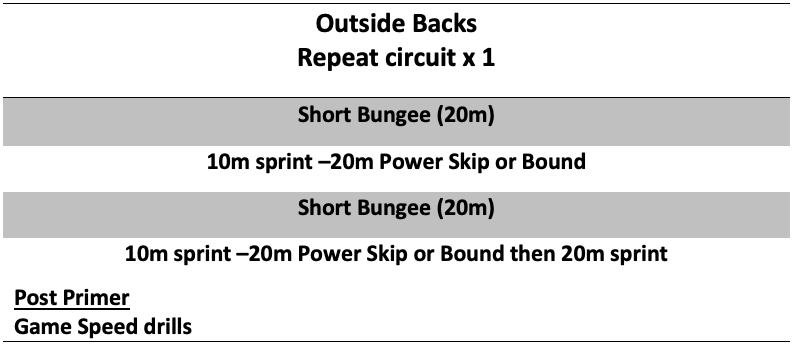
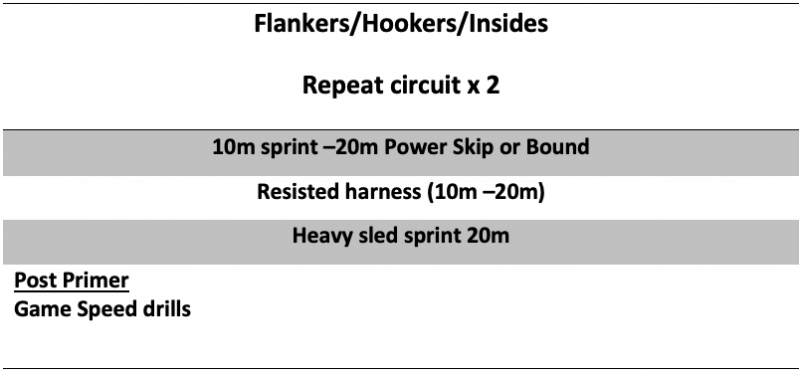
Fitness Extras
Depending on what the player requires, it can be off feet, running based, or gym based via circuits. An array of these metabolic sessions can be found in my article “Weapons of Metabolic Disruption.”
Recovery
This is an area that I consider to be less than ideally handled by myself, as players are in a hurry to get away from the facility or seek treatment from the medical staff or speak to coaches. All valid reasons, but I should stay more firm by the quote “The ability to train is governed by the ability to recover.” So, to shortchange this area is certainly going to be an issue for performance. Many players do take care of their own recoveries, but I have used the following previously as a key to gain buy-in, especially on this day, the biggest training day of the week. The concept was first used in an Australian rules football team, and I consider it to be an excellent way in which to gain the compliance we need in this key area. And, of course, you can weigh the sessions to your personal preference.
Post Training Recovery
Every Player Must Earn at Least 100 Points after Training
Points Activity
50 20-minute swim in pool or ocean
50 30-minute massage
30 10-minute cold water immersion
30 15-minute stretch session
30 Wear skins for at least 1 hour
30 3 x 3 minutes of cold, 1.5 minutes of hot contrast
20 Protein shake
20 15 minutes on spin bike
10 10-minute walk in the field
10 10-minute foam roller session
Game Day +4/-3 (Wednesday)
Again, often the day off mid-week for players, it should be noted that it is a day of recharge and rejuvenation, rather than just rest and recovery, so stay active, and partake in recreational activities, rather than parking up on the lounge for the day. This is important, as the next training day will be a high-intensity training day. So you need to be ready to go and not spend the first 30 minutes of the sessions getting ready for it, if you have tightened up due to a day of total inactivity.
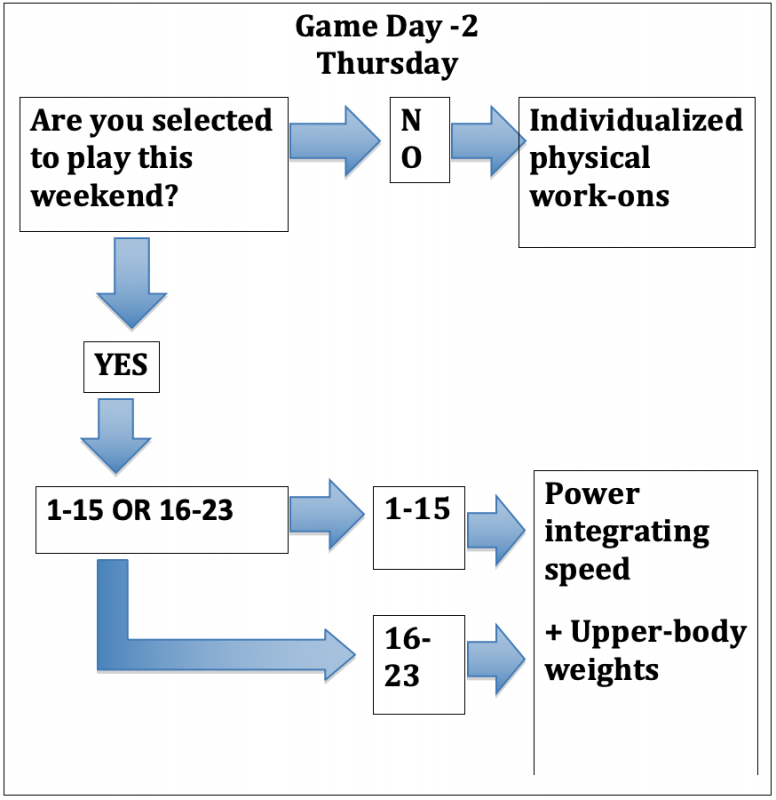
Game Day -2 (Thursday)
The non-selected players will still be required to partake in the training session for the day, but if they are not playing, it is very important to address the reasons why they have not been selected and to focus the work on this day to gain improvement. It could be more of a skill-based day or a day for addressing physical components, such as being fitter, faster, or stronger, utilizing the elements of the program that have been discussed previously. The use of a speed power combo session would be ideal for non-selected players:
Speed Power Combo Option
Option 1: Lateral Speed Agility Focus
- Warm-up – Ladder Patterns/Lateral Running Drills
- Hang Split Power Snatch, 8 sets x 3 reps
- Lateral Resisted March/Skip/Run & Release
- Hang Power Clean, 6 sets x 4 reps
- Agility Drills, Pro Agility Per Sheet
- Lateral Squat/Reverse Lunge into Step-Up with Slosh Bag 4 x 6
- Lateral Plyometrics
- Monday: Heavy Olympic - Snatch, Clean, or Pull + Single-Leg Super
- Set Hinge Movement/Knee Movement
Option 2: Power Acceleration Focus
- Warm-up – Hurdle Patterns with Range of Hurdle Sizes, Hops/Jumps
- 3 Position Power Snatch, 8 sets
- Starts Over 10 – 20 Meters from a Range of Different Starting Positions
- Clean Pulls, 6 sets x 4 reps
- Harness & Release Sprints
- Jump Squats, 4 x 6
- Sled Pulls & Prowler® Pushes
- Wednesday: Heavy Squat - Front, Back, or Box + Single-Leg Hinge Movement
Option 3: Maximal Velocity Focus
- Warm-up – Sprinters’ Movement Pattern Warm-Ups
- Med Ball Throws
- Plyos/Flying into Sprints
- Snatch Pulls, 6 x 4
- In & Outs/Crossover Sprints
- Power Step-Ups + Plyometrics (Box Jumps)
- 20m, 40m, 60m Straight-Line Sprints
- Friday: Heavy Deadlift - Trap Bar or Regular + Single-Leg Quad/Knee Dominant Movement
The players selected to play can use the following plan prior to the training session:
Power Speed Activation Session
You can choose any of the following to perform in this session; performance is the key in your selection.
Speed
10m or 20m or 30m: 1 to 5 reps through the gates
Weighted Power Movements
3 sets x 3 – 5 reps @ 60% - 70% from Floor/Hang/Blocks
- Prowler® Push (High or Low Handles)
- Weighted Sled Sprint/March
3 x 10 meters
- Banded Leg Drive
3 x 10 each leg
Unweighted Lower Body Plyometric Movements
3 sets x 5 reps
- Box Jumps/Hops
- Depth Jumps
- Repeat Long Jumps/Hops
- Repeat Hurdle Jumps/Hops
- Borzov Hops
- Alternating Bench Blasts
- Knees to Feet
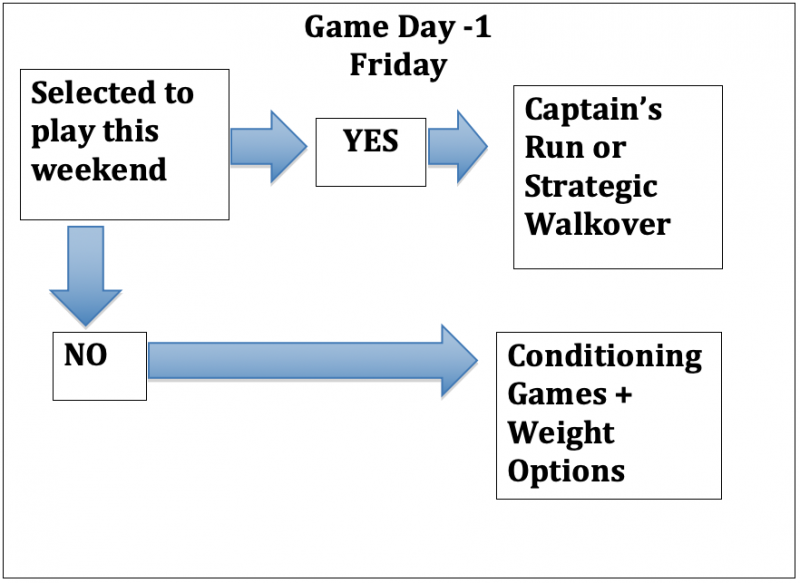
Game day -1 (Friday)
On the final day of the weekly in-season cycle, most teams will conduct a captain’s run, which is a dress rehearsal of key plays and a final revision of roles under the leadership of the captain. Often I have seen teams have this as a walkthrough only and discuss scenarios at different positions on the field. For example, players may be awarded a penalty with 5 minutes to go in the game and may be down by four points, so they must score to try to win the game. What do we do? Take a scrum, kick it out, and take a line out. What launch play are we going to run off this? What are each of our roles? On other teams, this is just a 20-minute team run at pace, at high intensity, and at low volume, finishing with unit work. Some players like to make a few high-speed running efforts on this day, whereas others will want to lift light and fast—for example, with cleans or snatches—and I have seen others work up to a 3RM on a bench press as well, all classified as primers. Meanwhile, others avoid any other activity other than the team session itself. The back end of the week is the player’s choice, and I am there to assist the players in getting what they need done to optimize their performance tomorrow.
The non-selected players will have a conditioning game session, getting speed and conditioning while working on skills, vision, and decision-making. This will be only about 30 minutes, as these players are on standby as well for if one of the selected 23 were to pull out of the game at the last minute. It is an enjoyable session of work rather than a punishing conditioning session because I believe that their mental states due to non-selection need to be looked after as along with their physical states.
This concludes the standard week-long plan with a seven-day turnaround between games. If games are played with different turnaround times, it is important to optimize the balance between recovery both physiologically and psychologically while also ensuring that the performance is not jeopardized for the following week.












I have a couple more questions for you if possible (especially your ideas with basketball training), what would be the best way to contact you? Hope you are doing well during this time!
Thanks for another great article. Good to get an insight into how you run your weekly program.
I have a few questions regarding your Game Day + 2.
• What protocol do you use for your Vertical Jump?
• What tool/protocol do you use to measure grip strength?
• How do you manage having players spread out over the 5 levels with only a certain amount of staff?
I really like how you have an emphasis on player mental well-being. For example on Game Day (-1) showing empathy to the players not selected in the match day 23, whilst letting those in the match day 23 dictate their intensity. Also providing players with different programming options to let them have a level of autonomy. When you get the right balance it can work wonders!
Cheers, Jono
1.we use a seated box jump set at 40cms, and use the Opto Jump, but a simple jump mat squat jump test would be fine for that as well
2. just a simple hand grip dynamometer, start with the arm raised above the head and squeeze as you slowly bring the arm down to the side
3. now that is the million dollar question, I use our medical staff to look after some groups, whilst I look after the more active groups, but also I believe in giving the players a lot of trust in setting the program and asking them to do it, so far not many do not live up to this trust
hope this assists, best wishes Ashley
Thanks for the reply!
What are your reasoning's for using a seated box jump set at 40cm, compared to say a CMJ or jump squat?
It always helps having a medical team that are willing to lend a hand in the gym, and to the S&C group!
Cheers, Jono
Would it be possible for you to do an article on return to gym post COVID ? I haven’t stepped foot in one since mid March and am concerned I might overload too quickly.
Thanks, Fred
Now that gyms are re-opening and many of you will be heading back into lifting, please, follow the rule of Hasten Slowly, just like a return to a running program, start out with lower volume and intensity, keep the reps above 6 for the next few weeks and start with roughly 60% of what you were doing for 6, it should feel relatively easy, increase your stretching post gym sessions, and gradually add weight say 15% a week, so a progression will look like this:
week 1 - 4 x 6 - 8 @ 60% of previous 6RM weight
week 2 - 4 x 6 - 8 @ 75%
week 3 - 4 x 6 - 8 @ 90%
week 4 - resume normal programming
Do not work to needing a spot on any exercise for at least 3 weeks
Do not max out on reps or intensity
Also this wonderful article maybe of some assistance as well https://www.elitefts.com/education/back-on-the-wagon-returning-to-training-after-a-long-layoff/
cheers, Ashley
More great info - and will definitely be using some of this to help out the squads this year.
Appreciate you sharing